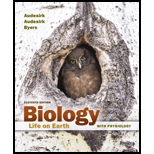
Biology: Life on Earth with Physiology (11th Edition)
11th Edition
ISBN: 9780133923001
Author: Gerald Audesirk, Teresa Audesirk, Bruce E. Byers
Publisher: PEARSON
expand_more
expand_more
format_list_bulleted
Concept explainers
Question
Chapter 4, Problem 9RQ
Summary Introduction
To determine:
The structure of cilia and flagella. Also, determine their movement and what their movement accomplishes.
Concept introduction:
Flagella and cilia are eukaryotic hair-like structures that extend outwards from the surface of cells. Cilia are generally shorter than flagella and are large in number. They are covered by plasma membranes and are supported by microtubules. Cilia and flagella help the cell in locomotion.
Expert Solution & Answer
Want to see the full answer?
Check out a sample textbook solution
Students have asked these similar questions
Generate one question that requires a Punnet Squre to solve the question. Then show how you calculate the possibilities of genotype and phenotype
Briefly state the physical meaning of the electrocapillary equation (Lippman equation).
Explain in a small summary how:
What genetic information can be obtained from a Punnet square? What genetic information cannot be determined from a Punnet square?
Why might a Punnet Square be beneficial to understanding genetics/inheritance?
Chapter 4 Solutions
Biology: Life on Earth with Physiology (11th Edition)
Ch. 4.1 - trace the historical development of the cell...Ch. 4.1 - list the three principles of the cell theory?Ch. 4.2 - describe the structure and features shared by all...Ch. 4.2 - distinguish prokaryotic from eukaryotic cells?Ch. 4.2 - Prob. 1TCCh. 4.2 - Prob. 1CSCCh. 4.3 - describe the structure and function of the major...Ch. 4.3 - describe the internal features of bacteria,...Ch. 4.4 - Prob. 1CYLCh. 4.4 - list the structures found in animal but not plant...
Ch. 4.4 - describe the structure and function of each major...Ch. 4.4 - What problems would arise if the trachea were...Ch. 4.4 - Why do the chromosomes in chromatin condense in...Ch. 4.4 - Using Fig. E4 4. plot the changes in each country...Ch. 4.4 - Why is it advantageous for all cellular membranes...Ch. 4.4 - Why is it important for lysosomal enzymes to be...Ch. 4.4 - CONSIDER THIS What advantages do bioengineered...Ch. 4.4 - Over the years, scientists have wondered how many...Ch. 4 - Which of the following is/are found only in...Ch. 4 - Which of the following is not a function of the...Ch. 4 - Prob. 3MCCh. 4 - Prob. 4MCCh. 4 - Prob. 5MCCh. 4 - Prob. 1FIBCh. 4 - Prob. 2FIBCh. 4 - Prob. 3FIBCh. 4 - Prob. 4FIBCh. 4 - Prob. 5FIBCh. 4 - Two organelles that are believed to have evolved...Ch. 4 - Prob. 7FIBCh. 4 - Prob. 1RQCh. 4 - Prob. 2RQCh. 4 - Prob. 3RQCh. 4 - Describe the nucleus and the function of each of...Ch. 4 - Prob. 5RQCh. 4 - Prob. 6RQCh. 4 - Describe the structure and function of the...Ch. 4 - Prob. 8RQCh. 4 - Prob. 9RQCh. 4 - List the structures of bacterial cells that have...Ch. 4 - Prob. 1ACCh. 4 - Prob. 2ACCh. 4 - What problems would an enormous round cell...
Knowledge Booster
Learn more about
Need a deep-dive on the concept behind this application? Look no further. Learn more about this topic, biology and related others by exploring similar questions and additional content below.Similar questions
- In a small summary write down:arrow_forwardNot part of a graded assignment, from a past midtermarrow_forwardNoggin mutation: The mouse, one of the phenotypic consequences of Noggin mutationis mispatterning of the spinal cord, in the posterior region of the mouse embryo, suchthat in the hindlimb region the more ventral fates are lost, and the dorsal Pax3 domain isexpanded. (this experiment is not in the lectures).a. Hypothesis for why: What would be your hypothesis for why the ventral fatesare lost and dorsal fates expanded? Include in your answer the words notochord,BMP, SHH and either (or both of) surface ectoderm or lateral plate mesodermarrow_forward
arrow_back_ios
SEE MORE QUESTIONS
arrow_forward_ios
Recommended textbooks for you
 Human Physiology: From Cells to Systems (MindTap ...BiologyISBN:9781285866932Author:Lauralee SherwoodPublisher:Cengage Learning
Human Physiology: From Cells to Systems (MindTap ...BiologyISBN:9781285866932Author:Lauralee SherwoodPublisher:Cengage Learning Human Biology (MindTap Course List)BiologyISBN:9781305112100Author:Cecie Starr, Beverly McMillanPublisher:Cengage Learning
Human Biology (MindTap Course List)BiologyISBN:9781305112100Author:Cecie Starr, Beverly McMillanPublisher:Cengage Learning Biology (MindTap Course List)BiologyISBN:9781337392938Author:Eldra Solomon, Charles Martin, Diana W. Martin, Linda R. BergPublisher:Cengage Learning
Biology (MindTap Course List)BiologyISBN:9781337392938Author:Eldra Solomon, Charles Martin, Diana W. Martin, Linda R. BergPublisher:Cengage Learning Biology Today and Tomorrow without Physiology (Mi...BiologyISBN:9781305117396Author:Cecie Starr, Christine Evers, Lisa StarrPublisher:Cengage Learning
Biology Today and Tomorrow without Physiology (Mi...BiologyISBN:9781305117396Author:Cecie Starr, Christine Evers, Lisa StarrPublisher:Cengage Learning Biology 2eBiologyISBN:9781947172517Author:Matthew Douglas, Jung Choi, Mary Ann ClarkPublisher:OpenStax
Biology 2eBiologyISBN:9781947172517Author:Matthew Douglas, Jung Choi, Mary Ann ClarkPublisher:OpenStax Concepts of BiologyBiologyISBN:9781938168116Author:Samantha Fowler, Rebecca Roush, James WisePublisher:OpenStax College
Concepts of BiologyBiologyISBN:9781938168116Author:Samantha Fowler, Rebecca Roush, James WisePublisher:OpenStax College

Human Physiology: From Cells to Systems (MindTap ...
Biology
ISBN:9781285866932
Author:Lauralee Sherwood
Publisher:Cengage Learning

Human Biology (MindTap Course List)
Biology
ISBN:9781305112100
Author:Cecie Starr, Beverly McMillan
Publisher:Cengage Learning

Biology (MindTap Course List)
Biology
ISBN:9781337392938
Author:Eldra Solomon, Charles Martin, Diana W. Martin, Linda R. Berg
Publisher:Cengage Learning

Biology Today and Tomorrow without Physiology (Mi...
Biology
ISBN:9781305117396
Author:Cecie Starr, Christine Evers, Lisa Starr
Publisher:Cengage Learning

Biology 2e
Biology
ISBN:9781947172517
Author:Matthew Douglas, Jung Choi, Mary Ann Clark
Publisher:OpenStax

Concepts of Biology
Biology
ISBN:9781938168116
Author:Samantha Fowler, Rebecca Roush, James Wise
Publisher:OpenStax College
Biology - Intro to Cell Structure - Quick Review!; Author: The Organic Chemistry Tutor;https://www.youtube.com/watch?v=vwAJ8ByQH2U;License: Standard youtube license